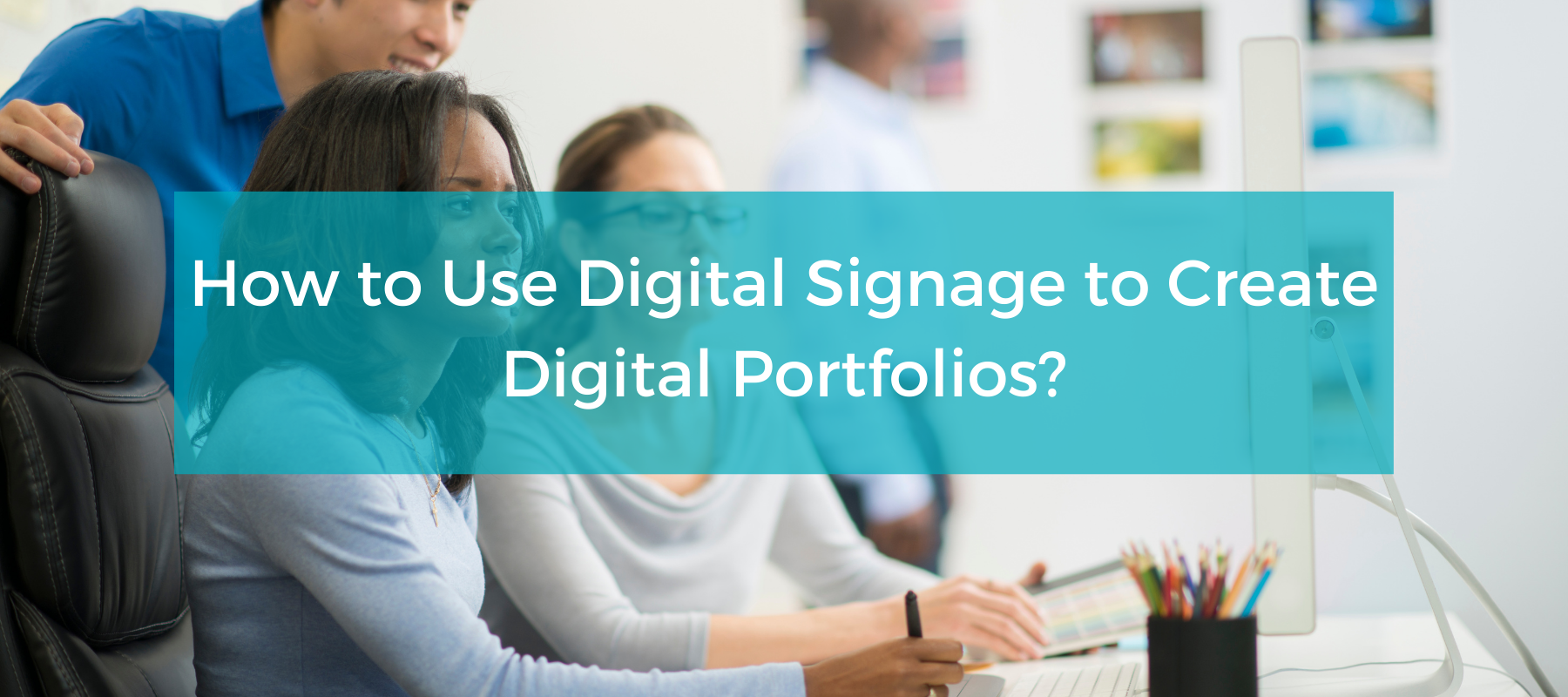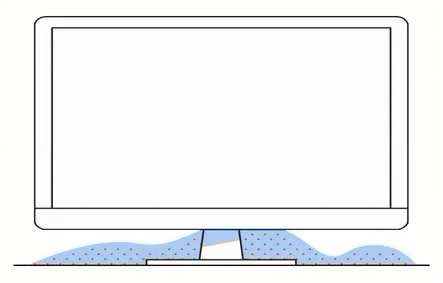
How to Use Digital Signage to Create Digital Portfolios?
There are so many skills and knowledge that students are exposed to, but it often goes unnoticed or forgotten.
Hypothetically, if a student writes down a note every month of what they learned, the contents of these notes can turn into a resume, cover letter, and even answers to interview questions.
However, not all skills can be best described with words, especially with hands-on experience. This is where creating a portfolio plays a role.
A portfolio is a collection of your best work, and the purpose is to highlight your creativity to potential colleagues, employers, and future partners you want to work with.
It is also a great way to communicate your talent and express what you can do for others. However, building a portfolio can take a lot of effort.
By the end of this blog post, you will learn how portfolios contribute to a student’s success and how top digital signage solutions can help students create their portfolios strategically.
What Is the Difference Between Paper Portfolios and Digital Portfolios?
While the initial stages of planning a portfolio start with thinking about the contents that are in it, it is crucial to understand the differences between paper versus digital portfolios.
Nowadays, we are used to seeing everything as digital. Because of this, having a paper portfolio is rare, but a few would still consider it a standard when applying professionally.
The reason could be that the content looks better on paper. In addition, the material can help highlight small details of the content that would not be as sharp on a screen.
Additionally, professionals who review digital portfolios all day find having a paper portfolio once in a while a refreshing experience. You can probably agree that the feeling of flipping a page versus swiping is more satisfying, especially when there is no loading time.
Lastly, since it is paper, there is no need to worry about internet connections or if the device is charged.
Even though we live in a technologically advanced era, the benefits of creating paper portfolios still exist.
But there are several reasons why people prefer making digital portfolios. The more projects you create, the more content to choose from. So, how can you create a portfolio that best expresses your current skills?
With free access to portfolio templates, you can set up a website to upload all your projects and then choose how you want your site to look. Many sites such as WordPress allow you to create different pages without any coding involved. You can personalize your site by making a short “About Me Page” and another page for your portfolio. You can customize other portfolios for different purposes, for example, portfolios for college, internship, job applications etc. Once the site is published, you can share the link, which is automatically updated whenever you make changes.
What is also great about digital portfolios is they are so easy to update. These updates can be done through a few simple clicks in the comfort of your home. Unlike paper portfolios, you can instantly email your updated digital portfolios and save money on travel expenses.
What Role Does Creating Digital Portfolios Play in Students’ Success?
Encourage your students to think about what types of content they should include in their digital portfolios. By planning ahead, students will learn how to achieve their goals and focus on the right projects that truly showcase their talents.
Here are ways to help students create digital portfolios that showcase their success:
Assigning Creative Projects:
Teachers are the closest to witnessing students' growth and can play a supporting role in their student's achievements. By assigning creative projects, an opportunity for students to express their ideas will open up and can help strengthen their social connections with other students.
There are lots of fun events and exciting celebrations that happen throughout the school year. In most cases, capturing these moments is typically assigned to the yearbook committee or the school's newspaper club. Still, this shouldn't stop teachers from encouraging their students outside of these groups to communicate insights that provide a new perspective for the team. By working together, students can combine their ideas and create content for their school and digital portfolios.

Host Competitions:
Encourage your students to participate in competitions that allow them to showcase their creations to the whole school! Whether the student works alone or as a team, the results of creating a plan and then successfully implementing it to the best of their abilities are what hosting these kinds of competitions is all about.
Another advantage is that a competitive event is where students can attain recognition, awards, and opportunities to strengthen their connections. These networks of people can become their advocates and provide advice to students that teach them how to build a more relevant digital portfolio.
Lastly, maybe it isn’t about the competitors. What about the impact on the people attending? Creating a place where students can showcase their projects can also motivate and inspire other students!
Hosting competitions is an event worth doing, especially when it comes to helping students realize that their ideas can become a reality and that creating meaningful content for their portfolios can be accomplished.

Establish the School’s Creative Team:
Have you ever struggled to think about what types of visuals or information would catch your school's interest if they were to pass by one of your displays? A dedicated team of talented individuals that does the research and brainstorm ideas is precisely why your school needs to have a creative team.
This creative team of students would be responsible for scheduling relevant information and capturing the intended viewers' attention. Having students participate in this team will get hands-on experience in creating content and gain instant feedback from seeing schoolmates' reactions.
Taking this opportunity, students can judge what content created is a success and improve their skills. In addition, teachers monitoring the team can have the role of mentors that provide feedback and the support needed to build the student's confidence and help find their style of creativity.
Students who are part of the creative team can also be assigned Rise Vision accounts under your primary account at no extra cost. This way, your students can get hands-on experience organizing content strategically. By learning how to organize digital signage content, students can also apply the same methods when deciding how they want to arrange their digital portfolio. Read more in this article and see how digital signage can increase student readiness to learn and become involved.

Schools are where students attend to learn and find their success. The exhilarating feeling of succeeding to the best of their abilities is the push students need to get that head start in creating their digital portfolios and executing a plan for their future successes.
How can Digital Signage Help Students Generate Their Own Digital Portfolios?
Now that we can see the relationship between digital signage and portfolios, here we will provide you with ideas on how students can use our digital signage software to create content for their own portfolios.
As mentioned earlier, if schools were to provide personalized projects, competitions or a creative team for the school, students will be able to build their skills and create a portfolio that makes them stand out from their competition.
Schools could provide projects where students are assigned to capture the best moments through pictures or videos from important events, holidays or any celebration that is happening in the school. Using digital signage, students' work can be displayed for the whole school to see. Additionally, just from observing, students get to witness live reactions from their schoolmates and boost their confidence in the long run.
Competitions can include who makes the best digital content and all the participants' work will be displayed on the displays!
Creative teams are responsible for brainstorming new ideas and will have the responsibility to schedule content that is relevant.
One of the biggest advantages of digital portfolios is that you are able to showcase videos! With this new YouTube update feature, schools are able to stream YouTube videos by simply copying and pasting the link. In our How to Make a YouTube Live Stream blog post, we show a step-by-step process on how your school can live stream using digital signage.

Key Takeaways:
Students should prepare a plan before creating their own portfolios. This will help them keep their focus and make better decisions when choosing what content to keep and what project best showcases the skills they want to highlight.
With the help of free digital signage, students can learn transferable skills that help them better understand how to organize their portfolios.
Teaching students how to use digital signage software to display their projects can boost their confidence in their work and allows them to receive feedback to further improve their skills.
More From Our Blog
-

Screen Sharing for Workplace Collaboration | Rise Vision
Screen-sharing technology has transformed how teams communicate and work together in real-time, regardless of their location. It can make presentations more engaging, support remote work, and speed[…]
Read More -

How to Use PowerPoint for Digital Signage
To create stunning, attention-grabbing, and effective digital signage content, you need the help of content creation and presentation tools. One of the most popular is Microsoft PowerPoint, owing to[…]
Read More -

120 Digital Signage Content Ideas
So…. you decided you would invest in some digital signage software and you need some ideas for ways you can make it stand out. This article is your go-to source for the best digital signage content[…]
Read More
Keep Your Displays Interesting – Pick New Templates Every Week!
Every week, we send template recommendations that will make you look great and improve your audience experience. And the best part, they save up to 16 hours of content creation time every week!
12,300+ Organizations Trust Rise Vision, You Can Too
Schedule a Free Demo
You deserve the #1 all-in-one platform for digital signage, screen sharing, and emergency alerts.



































